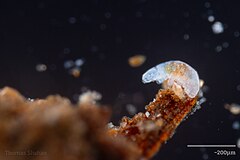User:FlipBrooke/nimisin: Difference between revisions
Content added Content deleted
FlipBrooke (talk | contribs) No edit summary |
FlipBrooke (talk | contribs) No edit summary |
||
| Line 15: | Line 15: | ||
The sitelen pona glyph for ''miko'' is a symbol of both an egg and an animal cell. A possible alt glyph depicts a tardigrade (<small>placeholder</small>). |
The sitelen pona glyph for ''miko'' is a symbol of both an egg and an animal cell. A possible alt glyph depicts a tardigrade (<small>placeholder</small>). |
||
miko can be used alongside |
''miko'' can be used alongside [[Animals|animal words]], ''[[kasi]]'' , and ''[[soko]]'' to describe [https://en.wikipedia.org/wiki/Kingdom_(biology) taxonomic kingdoms], allowing every species to be described roughly taxonomically. |
||
Revision as of 18:29, 8 March 2024
nimi sin tan jan Sowi
miko
 | |
| Pronunciation | /ˈmi |
|---|---|
| Usage | 2023: N/A |
| Book and era | No book |
| Part of speech | Content word |
miko is a content word relating to simple living things, including cells or microorganisms. miko also refers to eggs, as they're often made up of a single cell. The word was coined by jan Sowi on 3/6/24.
mi moku e [seme] wasomi moku e miko waso
I ate bird eggs
The sitelen pona glyph for miko is a symbol of both an egg and an animal cell. A possible alt glyph depicts a tardigrade (placeholder).
miko can be used alongside animal words, kasi , and soko to describe taxonomic kingdoms, allowing every species to be described roughly taxonomically.